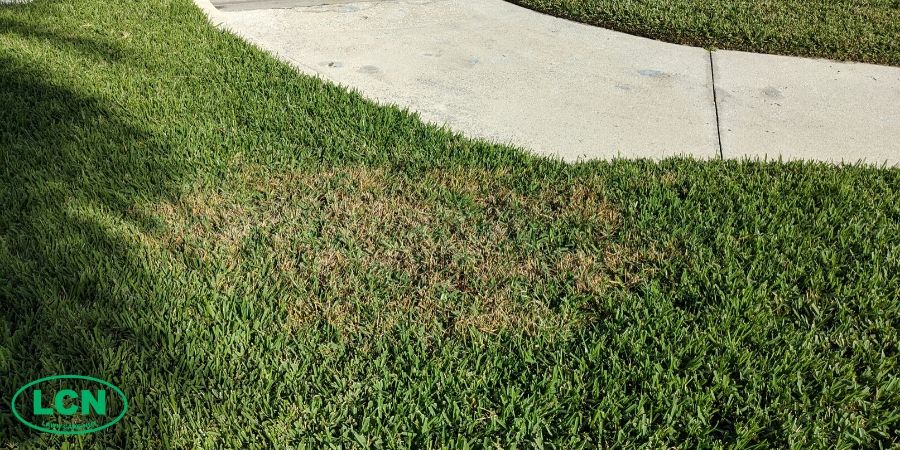How to Manage Large Patch Lawn Disease
- "The Lawn Care Nut"March 28, 2020
As much of the country’s weather is starting to unfold winter and head into spring, those of us down south have been out and caring for our lawns for several weeks now. Down here in South Florida, I actually never stopped, and neither did the Large Patch disease.
Large Patch is caused by the pathogen Rhizoctonia solani and is the same disease that is found in cool-season turf, especially turf type tall fescue, called Brown Patch. I see it mostly in St Augustinegrass and Zoysia, but it can attack centipede and bermuda.
The thing about this one that causes the most concern though, is that it lasts in the lawn from season to season. I got a small outbreak in my Palmetto St Augustine last fall and treated it, but I have noticed it already this spring trying to rear itself back up again.
It’s not hard to identify because it forms irregular ring shapes in the lawn and where the disease is most active, the grass blades will be a dark yellow to light orange and when you pull out a few blades, the basal area will be black.
This is also why this disease is oftentimes referred to as “root rot.”

To fully ID Large Patch, pull a few blades of your St Augustine and you can see where the leaf blade and stem meet, called the “basal area” will be black.
Large Patch will start to get worse and worse as the spring wears on and the rain starts to kick in. So far this season here in Florida we have been very dry. I don’t think we have had rain in over a month which is pretty typical for this time of year. Our rainy season is May - September but as we approach that time, and start getting into April, humidity will rise, we will start to see some of that afternoon thunderstorm pattern emerge and the Large Patch will begin to rage.
Now don’t be scared! Just follow these general best practices and your lawn can get through even the worst outbreak. Remember, our grass types are “self-healing.” When they are damaged, they have the ability to send out new “runners” in the form of stolons and rhizomes that take back ground that was lost to areas that died off, and this brings me to my first tip.
Here is an area in my Palmetto St Augustine that was infected with Large Patch last fall and continues to be a challenge into this spring.
Large Patch Disease - Still Feed The Lawn
One way to increase the spread of Large Patch is to hit your lawn with high doses of quick-release nitrogen. When you do this, you trigger fast growth of new, tender leaf tissue and you literally give the disease more surface area to infect. But that doesn’t mean you have to go to the opposite extreme and cut off all nitrogen. If you do that you will starve the plant and a hungry plant has no way to repair itself.
Instead, use a lean approach. If you have Large Patch present, give your lawn a spoon feeding of Milorganite every 5 weeks to keep it moving. I’m talking somewhere around 8lbs/1000 sq ft and no more. Since Milorganite is 6% slow-release nitrogen, this will yield .48lbs/N/1000 which is not going to push any surge growth but instead, will lightly feed the turf and help it to sustain some growth until conditions level off and the disease goes back into dormancy.
The 4% phosphorus will also help your turf add more roots to support this new growth over time.
Fungicides Are An Option Early
If you have a major outbreak, you may want to apply some fungicide. It’s best to do this prior to seeing the disease symptoms and re-apply about every 30 days through spring according to the label on the product you get. Pretty much any fungicide you can find at your local big box store will work. Down here in Florida the stores know that Large Patch is a problem and they are already stocked up in preparation.
Simple Best Practices
Of course, you also want to follow the more simple best practices that we talk about with any lawn disease and that is to catch/bag your clippings when disease is present, and also make sure when you irrigate, you are setting your system to come on in the mornings before 11AM so the grass can drink and the rest can dry off quickly. Irrigate lean, don’t keep your ground saturated. Let the soil dry out some between watering days.
One extra strategy I have employed is to go out in the mornings with my leaf blower and blow the dew off infected areas to help them dry out more quickly. One thing that can help the lawn when you have Large Patch is good airflow and there is nothing better at creating instant airflow than a leaf blower. This tip is only for the most nutty amongst you!
Just know, if you have Large Patch in your lawn this spring, it will probably rear up again in the fall and these same best practices will need to be employed. Stay on a low nitrogen spoon feeding regiment during the times when Large Patch is raging, namely later spring and fall, apply fungicides if you must, catch and bag clippings, and your lawn will be able to withstand it and eventually, you may see no symptoms at all. As always, let’s hope for the best!


